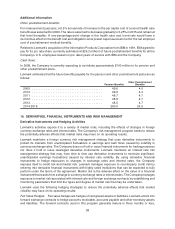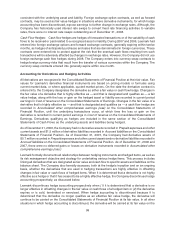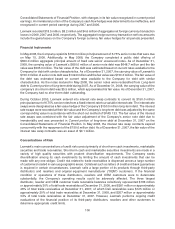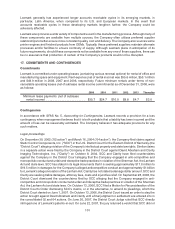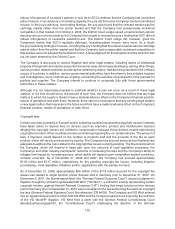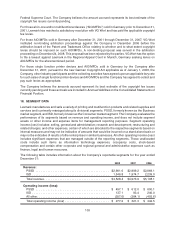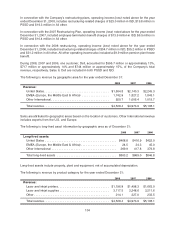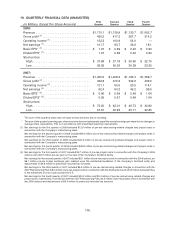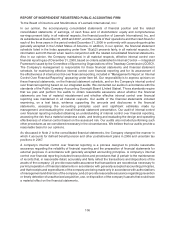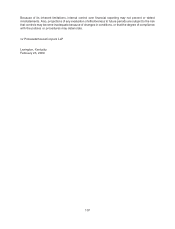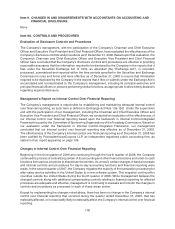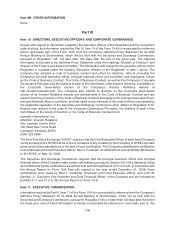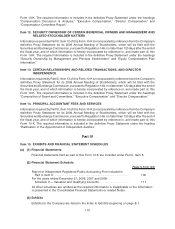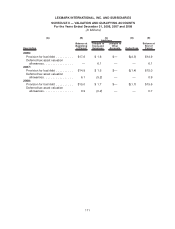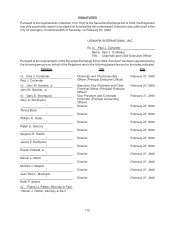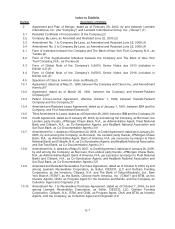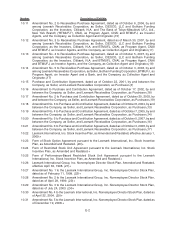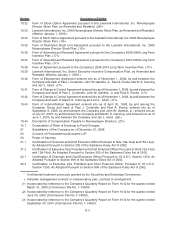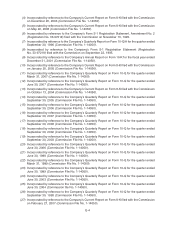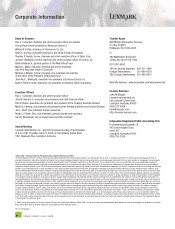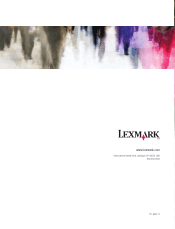Lexmark 2008 Annual Report Download - page 114
Download and view the complete annual report
Please find page 114 of the 2008 Lexmark annual report below. You can navigate through the pages in the report by either clicking on the pages listed below, or by using the keyword search tool below to find specific information within the annual report.Item 9. CHANGES IN AND DISAGREEMENTS WITH ACCOUNTANTS ON ACCOUNTING AND
FINANCIAL DISCLOSURE
None
Item 9A. CONTROLS AND PROCEDURES
Evaluation of Disclosure Controls and Procedures
The Company’s management, with the participation of the Company’s Chairman and Chief Executive
Officer and Executive Vice President and Chief Financial Officer, have evaluated the effectiveness of the
Company’s disclosure controls and procedures as of December 31, 2008. Based upon that evaluation, the
Company’s Chairman and Chief Executive Officer and Executive Vice President and Chief Financial
Officer have concluded that the Company’s disclosure controls and procedures are effective in providing
reasonable assurance that the information required to be disclosed by the Company in the reports that it
files under the Securities Exchange Act of 1934, as amended (the “Exchange Act”), is recorded,
processed, summarized and reported within the time periods specified in the Securities and Exchange
Commission’s rules and forms and were effective as of December 31, 2008 to ensure that information
required to be disclosed by the Company in the reports that it files or submits under the Exchange Act is
accumulated and communicated to the Company’s management, including its principal executive and
principal financial officers or persons performing similar functions, as appropriate to allow timely decisions
regarding required disclosure.
Management’s Report on Internal Control Over Financial Reporting
The Company’s management is responsible for establishing and maintaining adequate internal control
over financial reporting, as such term is defined in Exchange Act Rule 13a-15(f). Under the supervision
and with the participation of our management, including the Chairman and Chief Executive Officer and
Executive Vice President and Chief Financial Officer, we conducted an evaluation of the effectiveness of
our internal control over financial reporting based upon the framework in Internal Control-Integrated
Framework issued by the Committee of Sponsoring Organizations of the Treadway Commission. Based on
our evaluation under the framework in Internal Control-Integrated Framework, our management
concluded that our internal control over financial reporting was effective as of December 31, 2008.
The effectiveness of the Company’s internal control over financial reporting as of December 31, 2008 has
been audited by PricewaterhouseCoopers LLP, an independent registered public accounting firm, as
stated in their report appearing on page 106.
Changes in Internal Control Over Financial Reporting
Beginning in the third quarter of 2006 and continuing through the fourth quarter of 2008, the Company
continued its process of centralizing certain of its accounting and other finance functions and order-to-cash
functions from various countries to shared service centers. As a result, certain changes in basic processes
and internal controls and procedures for day-to-day accounting functions and financial reporting were
made. In the second quarter of 2007, the Company migrated the majority of the transaction processing for
after-sales service activities in the United States to a new software system. This migration continued for
countries outside the United States during the fourth quarter of 2008. While management believes the
changed controls along with additional compensating controls relating to financial reporting for affected
processes are adequate and effective, management is continuing to evaluate and monitor the changes in
controls and procedures as processes in each of these areas evolve.
Except for implementing the changes noted above, there has been no change in the Company’s internal
control over financial reporting that occurred during the quarter ended December 31, 2008, that has
materially affected, or is reasonably likely to materially affect, the Company’s internal control over financial
reporting.
108


